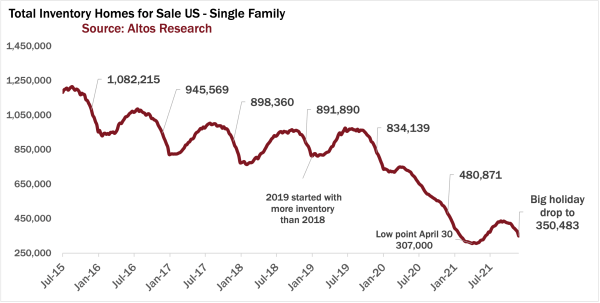As we close out 2021, it’s time to not only take stock of the year, but look ahead at what the new year holds for real estate. Let’s begin with Mike Simonsen of Housing Wire who has 3 predictions for the coming year:
- Housing demand will remain strong throughout 2022.
- Housing supply will continue to be very limited in the near year.
- Prices of homes will continue to go up in 2022.

Source: Housing Wire (Dec. 2021)
As we look towards 2022, all the leading indicators show tight inventory and strong demand keeping prices high — a strong seller’s market. If interest rates start rising, and we’re seeing inflation or other economic challenges, this could have a cooling effect on the market. These variables aren’t in the data yet, but they’re looming. We’ll want to keep watching the data closely to spot any major shifts.
Realtor.com outlined what they believe based on data will be the hottest U.S. markets in 2022, meaning investors in these areas will need to prepare a focused approach to account for more competition.

Source: Realtor.com (Dec. 2021)
Jennifer Taylor of Yahoo! Finance continues the conversation with more predictions for 2022:
- Larger cities may surge again.
- The rate of home value appreciation will slow.
- Inventory will stay low.
- Interest rates will rise, but not a lot.
Finally, Zillow provides its own take on what 2022 has in store for real estate:
- 2022 will continue to be a seller’s market.
- Bigger rentals will be in higher demand.
- Secondary markets will have a good year.
- More Gen Zers and millennials will buy a second home before a primary one.
- The renovation boom will continue.
- New construction will continue to lag demand.
Supply and demand
We continue to see a strong imbalance between supply and demand in U.S. housing. Redfin reports that homes for sale hit a record low by the end of November. Redfin Chief Economist Daryl Fairweather notes:
“The number of homes for sale typically declines another 15% in December…That means that by the end of the year, there will likely be 100,000 fewer homes for sale than there were in February when housing supply last hit rock bottom. I think more new listings will hit the market in the new year, but there will also be a long line of buyers who are queuing up right now.”
Tim Ellis of Redfin continues to note this drop in active home listings was down 25% from 2020, and 43% from 2019. In a further indicator of strong demand, 31% of homes that went under contract did so within a week of hitting the market, up from 26% in 2020, and 17% in 2019.

Source: Redfin (Dec. 2021)
In commenting on the demand side, Liz Brumer-Smith of Motley Fool notes that “Low interest rates have been a big driving force in creating new demand for homes in 2021. The Federal Reserve has stated it plans to increase rates marginally in 2022, but the move won’t happen until mid-to-late 2022. An increase in interest rates and today’s already record-high housing market means fewer people will be able to afford these home prices, and demand will likely cool a bit. But slowing demand doesn’t necessarily mean things will be back to normal in 2022.”
Further, Zillow reports on the relationship between demand for housing and inflation, noting that if household incomes rise so too will housing demand.
Not enough lots
Not enough housing is one thing, but builders are also finding it difficult to find enough lots. According to the National Association of Homebuilders (NAHB), we are currently experiencing the worst lot shortage ever.
NAHB released a newer study showing that builders are increasingly relying on demolitions and infills given the above-noted lot shortage.
“One in four new single-family detached homes were built in established neighborhoods in 2020. This includes 19% of new homes that were built on infill lots and 6% that involved tearing down an old building prior to building a brand new single-family detached home. These shares vary significantly across the United States. In 2020, teardowns and infills accounted for almost half of the new-home market in New England but their prevalence in the Midwest was under 20%.”

Source: NAHB (Dec. 2021)
In commenting on the above data, Realtor Magazine noted “Builders have reported a record high of lot shortages. As such, the number of new homes constructed on infill lots will likely continue to increase.”






